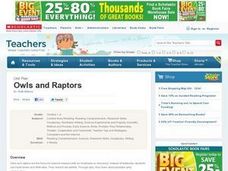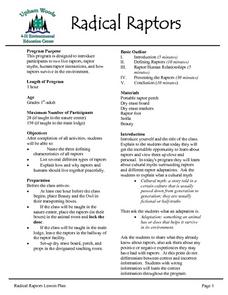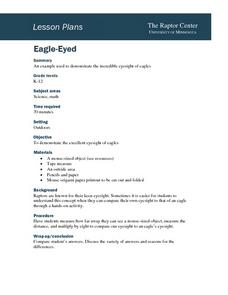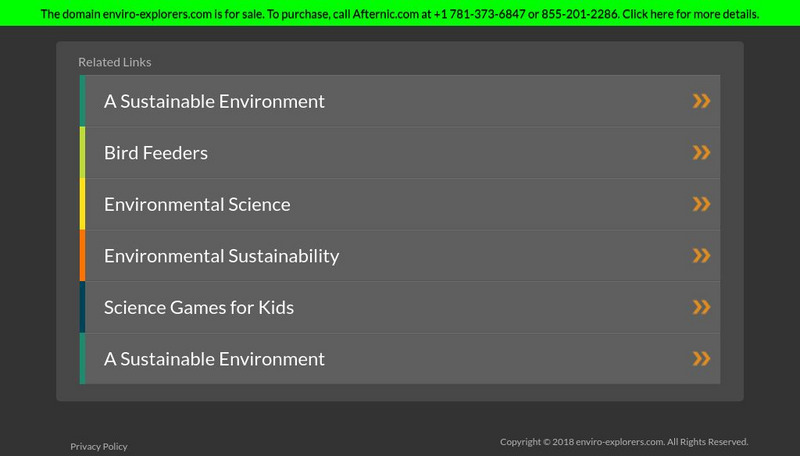Curated OER
The Legendary Raptors
How are raptors and airplanes alike? Combine science and language arts in this fun and interactive project. Young scientists research the animal in order to design their own aircraft, and compete in a contest for farthest, fastest, and...
California Academy of Science
Using Empirical Data in the Classroom: Raptor Migrations!
Raptor flight patterns align with seasonal changes in net primary productivity. Here is a thought-provoking lesson that uses empirical data from a video to help scholars understand raptor migrations, producers/consumers, and ecosystems....
Curated OER
Owls and Raptors
Students investigate the predator-prey relationship of owls and raptors. They examine a variety of resources about owls and raptors, develop a list of vocabulary words, dissect owl pellets and identify what owls eat, and play a...
Curated OER
Radical Raptors
Students are introduced to raptors and their role in the environment. They identify three characteristics of raptors and list several types of raptors found in nature. They discuss their positive and negative experiences with raptors and...
Curated OER
Radical Raptors
Students define raptor, explain why raptors are important, describe unique physical characteristics of various types of raptors, and explain life cycle of raptors. Students then play Habitat Game, describe food and hunting habits of...
Curated OER
Recycling for Raptors
Students write persuasive letters in support of the Recycling for Raptors campaign. They review raptor groups and names and categorize the raptor species and the groups which they belong. They research businesses, schools, and...
Curated OER
Raptor Poetry
Young scholars create poems about raptors. They discuss raptors and create three poems including at least two of the following: haiku, diamante, found, and acrostic. They create a classroom book of poems or conduct a poetry slam where...
Curated OER
Eagle-Eyed
Students study the eyesight of eagles. They discuss raptors and their eyesight and compare it to their own. They measure how far away they can see a small object and its distance. They calculate the eyesight to measure an eagle's...
Curated OER
Raptor Poster Project
Learners create posters about raptors. They synthesize information they read about raptors and select a raptor. They draw a picture of their raptor and include facts relating to where it lives, characteristics, feeding habits, size, name...
Curated OER
Eagles and Other Raptors
Students become familiar with basic facts and behavior of the American Bald Eagle using a combination of classroom presentation, Video, Internet searching, "hands on" computer activity, and touching of feathers and displays.
PBS
Idaho Public Television: Birds of Prey Facts
Dialogue for Kids, a program on Idaho Public Television, offers facts, information, and images of birds of prey. Learn what makes a bird a raptor, what raptors look like in the sky, threats that face these birds, and more! Classroom...
San Diego Zoo Global
San Diego Zoo: Bald Eagle
This resource presents a complete fact sheet on bald eagles that includes a look at why bald eagles are "bald," what bald eagles eat, how their vision works, their courtship and mating behavior, their nesting and reproductive behaviors,...
PBS
Nh Pbs: Nature Works: Bald Eagle
A clear and concise look at bald eagles, with information on habitat, life cycle, reproduction, diet, and more.
Sheppard Software
Sheppard Software: Ospreys
This site gives an in-depth description of an osprey, including its behavior, appearance, reproduction, and classification. The site includes photos and illustrations and an interactive quiz to test your understanding.
Alberta Birds of Prey Foundation
Alberta Birds of Prey Foundation: Golden Eagle
This fact sheet about the golden eagle gives information about appearance, diet, habitat and nesting.
Annenberg Foundation
Annenberg Learner: Journey North: Frequently Asked Questions About Bald Eagles
Questions and answers that touch on all the essentials about bald eagles (anatomy, reproduction and young, diet and feeding behaviors, migration and flight, habitat and range, and conservation).
Other
Ninepipes Center for Wildlife Research: Homepage
This site from the Ninepipes Center for Wildlife Research & Education provides information on its programs, research projects, and publications. Teachers and students will find links to other wildlife sites and photographs and...
National Audubon Society
National Audubon Society: Bald Eagle
Find the drawing and original text of the entry about the bald eagle from John James Audubon's 1840 edition of "Birds of America."
PBS
Pbs: Nature: Raptor Force
Online companion of a Nature documentary about birds of prey, their sense of sight, and their powers of locomotion. Includes a game, Raptor Vision, that lets players see the world through the eyes of a raptor.
DLTK
Kidzone: All About Birds
This is comprehensive site covers the characteristics of birds and looks at various birds through pictures and words. Several puzzles are included and the degree of difficultly can be changed.
National Audubon Society
Audubon Adventures: Hunter & Hunted
Beak and talon. Eye and wing. These are the tools of the aerial hunter. Most raptors eat a variety of things, but there are usually a few kinds of prey that a particular raptor is especially equipped to hunt. See if you can match the...
Quia
Quia: Bald Eagle Basics
Find four games and activities--flash cards, a matching game, a concentration game, and a word search--that test your knowledge of bald eagles.
PBS
Pbs: Nature: Raptor Vision Game
Gain 20/7 vision by becoming a raptor in this game! Help the Peregrine falcon find its prey in a river scene and see the difference between your vision and its vision!
Other
Enviro Explorers Kids' Club: Bald Eagle Puzzle
After dragging pieces of a puzzle into place to complete a picture of a bald eagle, link over to a page of kid-friendly facts about this bird of prey.






















